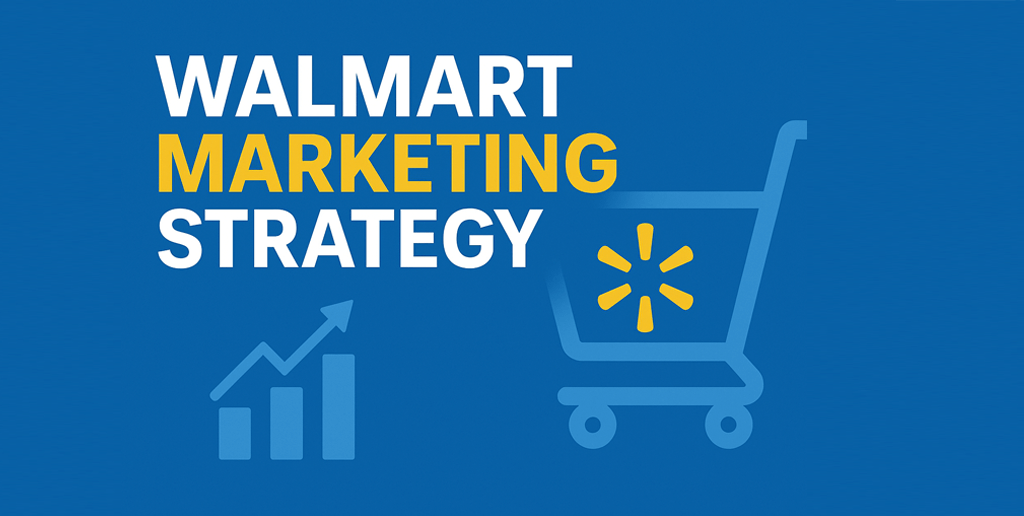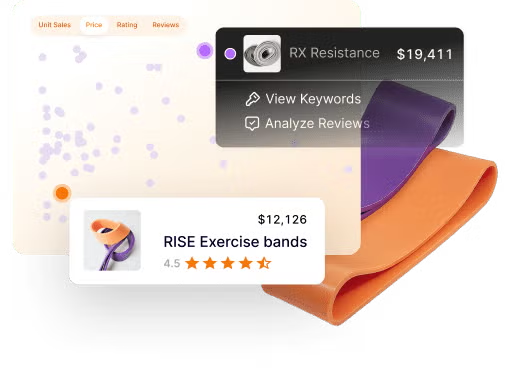Walmart is one of the world’s retail giants, and its marketing strategy reflects a sophisticated blend of low-cost leadership, operational efficiency, brand building, and social responsibility. In this article, we unpack Walmart’s marketing strategy – including its tactics, business strategy, supply chain, advertising, and corporate values – to provide a deep dive for readers interested in how this powerhouse remains competitive and relevant.

Walmart’s Core Marketing Strategy
At the heart of Walmart’s marketing strategy is its everyday-low-price (EDLP) promise. Rather than relying on frequent sales or discounts, Walmart emphasizes consistent value. This strategy is embodied in its tagline:
“Save money. Live better.”
By focusing on low cost, Walmart positions itself as the go-to retailer for budget-conscious consumers, reinforcing trust and reliability in its brand messaging.
Walmart’s business strategy is tightly interwoven with this marketing approach. Its scale allows it to negotiate favorable deals with suppliers, driving costs down, which in turn funds its low-price commitments.
Key Walmart Marketing Tactics
Walmart employs a number of marketing tactics to reinforce its value proposition and engage audiences:
- Value-driven communications: Emphasizing cost savings rather than premium or luxury.
- Omnichannel presence: Walmart integrates its physical stores with its digital platforms (app, website), enabling a seamless experience for customers.
- Personalization and data analytics: Through customer data and business intelligence, Walmart tailors offers and forecasts demand, improving the ROI of its marketing spend.
- Partnership and supplier engagement: Walmart works closely with vendors to maintain low cost and good product flow, which supports its marketing promise.

Walmart Advertising Strategy and Campaigns
Walmart’s advertising strategy is not just about promoting low prices – it’s about building long-term brand equity:
- Consistent message: Advertising centers on the EDLP promise, reinforcing Walmart’s reliability and affordability.
- Digital-first campaigns: Walmart has invested heavily in digital advertising, including its own platform, Walmart Connect, which lets brands advertise directly to Walmart shoppers via its app and website like walmart seller central.
- Innovative experiences: In some recent moves, Walmart is exploring immersive shopping experiences to engage customers in new ways.
- Behavioral targeting: Using data and AI, Walmart can serve relevant ads and promotions based on customer behavior on Walmart.com, increasing efficiency.
Walmart Business Strategy, Supply Chain, and IT Strategy
To support its marketing, Walmart relies heavily on an efficient supply chain strategy and advanced IT strategy:
- Hub-and-spoke distribution: Goods are distributed from central hubs to regional centers, optimizing logistics and reducing replenishment times.
- Supplier partnerships: Centralized procurement, long-term relationships with vendors, and high-volume purchasing give Walmart leverage.
- Automation and innovation: Walmart is increasingly using robotics and automation in its fulfillment centers, improving efficiency and reducing costs.
- Real-time decision-making: Sensors, IoT, and data analytics feed into Walmart’s AI systems, enabling precise inventory management and smarter marketing decisions.
Walmart and Social Media
Walmart and social media play a growing role in its marketing:
- Engagement on platforms: Walmart uses its app and social channels to interact with customers, run promotions, and build brand affinity.
- Content marketing: Through educational content and lifestyle storytelling, Walmart aims to elevate its brand beyond simply low-price
- Influencer collaborations: While Walmart’s core is everyday retail, it occasionally partners with trendy brands and creators to reach younger or more affluent audiences.
Walmart’s Values, Mission, Vision & Corporate Social Responsibility (CSR)
Walmart’s values and organizational culture are integral to its brand and marketing:
- Core values: Walmart emphasizes respect for the individual, service to customers, striving for excellence, and acting with integrity.
- Corporate Social Responsibility (CSR): Walmart invests in sustainability, renewable energy, and supplier ethics.
- Social responsibility: The company also engages in community projects and social initiatives that reinforce its image as a responsible global retailer.
Walmart’s Leadership, Marketing Team & Organizational Culture
- Leadership principles: Walmart’s leadership reinforces a culture of cost discipline, operational excellence, and customer-first thinking.
- Marketing team: Experienced in data-driven marketing, cross-platform campaigns, and digitally centered strategy (especially with Walmart Connect).
- Culture: Walmart has a performance-focused culture rooted in efficiency, innovation, and maintaining its core mission to help people live better.
SWOT Analysis for Walmart (Marketing Perspective)
Here’s a SWOT for Walmart focused on its marketing and strategic position:
- Strengths:
- Massive scale and buying power.
- Highly efficient supply chain.
- Strong data analytics and business intelligence capabilities.
- Weaknesses:
- Perception as low-cost only; may struggle to be seen as premium.
- Thin margins due to low-price model.
- Opportunities:
- Expand e-commerce and omni-channel experiences.
- Use AI and automation to further optimize operations.
- Grow sustainability and CSR efforts to improve brand reputation.
- Threats:
- Competition from Amazon, Target, and other e-commerce platforms.
- Supply chain disruption risk.
- Regulatory or reputational risks around labor practices.
Porter’s Five Forces Analysis of Walmart
Using Porter’s Five Forces, we can analyze Walmart’s strategic positioning:
- Competitive Rivalry: Very high. Walmart competes with other large retailers (e.g., Amazon, Target).
- Supplier Power: Moderate to low. Walmart’s scale gives it strong bargaining power.
- Buyer Power: High. Customers can choose from many retailers, but Walmart’s value proposition helps retain them.
- Threat of Substitutes: Moderate. There are many ways to shop (online, discount stores), but Walmart’s scale and mix provide resilience.
- Threat of New Entrants: Low. The retail scale, logistics, and brand make it hard for new players to match Walmart easily.
Walmart Corporate Strategy & Business Intelligence
- Corporate strategy: Walmart blends cost leadership with growth in e-commerce, leveraging technology and supplier relationships to scale.
- Business intelligence: Walmart invests heavily in analytics, AI, and real-time data to guide not only operations but its marketing campaigns. Detailed customer insight helps it tailor ads, optimize inventory, and reduce waste.
- Innovation: Projects around virtual shopping, robotics, and sustainable technology show Walmart’s commitment to modernizing its business.
Walmart Sales Promotions & Advertising Campaigns
While Walmart doesn’t rely on heavy promotions, it uses targeted sales promotions and ad campaigns strategically:
- In-app and online deals tailored by customer behavior.
- Brand storytelling campaigns on social media to reinforce values.
- Programmatic ads through Walmart Connect for partner brands.
- Sustainability messaging in campaigns to highlight CSR actions.
Walmart SEO, E-commerce, and Digital Marketing
- SEO & Content: Walmart uses its website and app to surface relevant products, content, and promotions. Its digital presence is optimized for search, both within Walmart.com and more broadly.
- E-commerce delivery strategy: Walmart supports pickup, delivery, and even in-home delivery, integrating logistics with its marketing to promise convenience.
- Digital ad agency and marketing agency relationships: Walmart partners with various agencies and also runs its own in-house marketing through Walmart Connect.
Corporate Social Responsibility (CSR) & Walmart’s Values
- CSR: Walmart has set ambitious sustainability goals, including waste reduction and renewable energy adoption.
- Corporate social responsibility in communities: Walmart invests in community programs, supports local suppliers, and emphasizes ethical sourcing.
- Mission and Vision: Walmart’s mission (“help people save money so they can live better”) aligns with its business model, marketing, and CSR initiatives.
Innovation & IT Strategy
- Retail innovation: Walmart is experimenting with virtual reality shopping environments, advanced automation in warehouses, and robotics to streamline its operations.
- Ad tech and e-commerce: Using language models and AI, Walmart improves ad targeting and search relevance on its e-commerce site.
- Supply chain tech: Real-time sensors on pallets feed into AI systems, enabling better forecasting and precision logistics.
Investor Relations & Corporate Governance
- Walmart stores investor relations: Walmart regularly reports strong financials, underpinned by its efficient operations, scale, and innovation.
- Leadership: The company maintains a board and executive leadership committed to long-term value, integrating sustainability goals and digital transformation into its core strategy.
People & Organizational Culture
- People of Walmart: Walmart employs a huge workforce globally. Its culture emphasizes performance, cost discipline, and innovation.
- Organizational culture: Driven by values like respect, integrity, and excellence. That underpins not just daily operations but long-term marketing and strategy.
Conclusion
Walmart’s marketing strategy is a masterclass in aligning brand promise with business operations that Swanseaairport want to share with you. Its low-price positioning is not just a slogan but rooted in an efficient supply chain, data-driven decision-making, and constant innovation. Through its advertising strategy, Walmart Connect, and social responsibility programs, it projects a progressive and reliable image. Its SWOT profile and Porter’s Five Forces analysis show how Walmart leverages its scale while carefully managing risks. Meanwhile, its commitment to sustainability, AI, and customer-centric marketing demonstrates that it’s not just looking to be a cost leader – it’s striving to be a smart, modern, and responsible retailer.


